Drought In Western Kansas Exacerbates Global Wheat Shortage
10:05 minutes
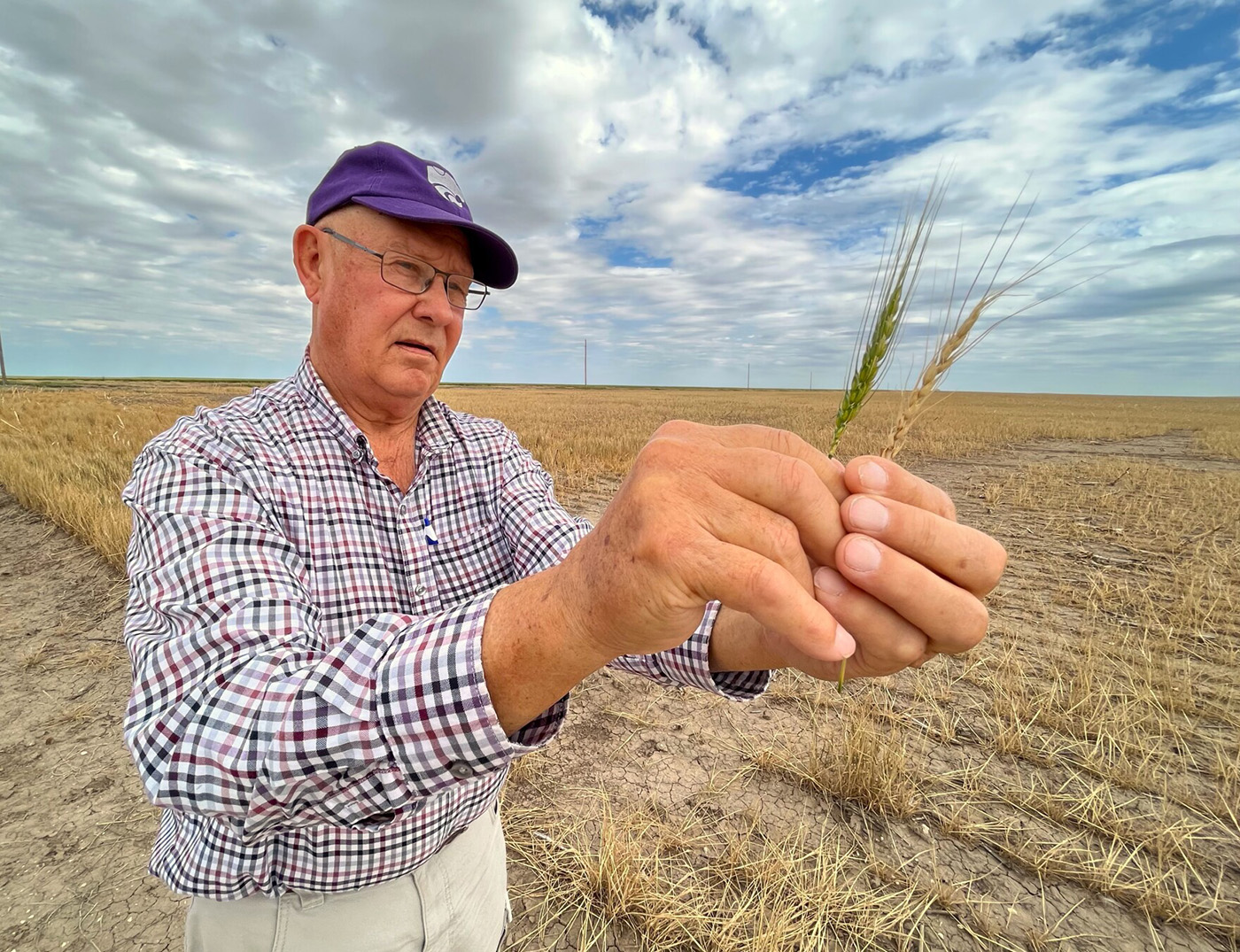
This article is part of The State of Science, a series featuring science stories from public radio stations across the United States. This story, by High Plains Public Radio reporter David Condos, was originally published by the Kansas News Service.
Russia’s war in Ukraine has disrupted global food supplies, driving up demand and prices for wheat. But after months of drought, many western Kansas farmers won’t have a crop to sell.
This time of year, the wheat growing in this part of western Kansas should be thigh-high and lush green.
But as a months-long drought continues to parch the region, many fields tell a different story.
“There’s nothing out there. It’s dead,” farmer Vance Ehmke said, surveying a wheat field near his land in Lane County. “It’s just ankle-high straw.”
Across western Kansas, many fields planted with wheat months ago now look like barren wastelands. The gaping spaces between rows of brown, shriveled plants reveal hardened dirt that’s scarred with deep cracks from baking in the sun.
Of all the years for drought to hit western Kansas wheat farmers, it couldn’t have come at a worse time.
Even with wheat selling for near-record-high prices as the war in Ukraine disrupts the world’s food supplies, a lot of farmers in western Kansas won’t have any to sell. And those who made it through the drought with enough crop to harvest will likely end up with far fewer bushels than they had last year, a downturn that limits the state’s ability to help ease the global food crisis.
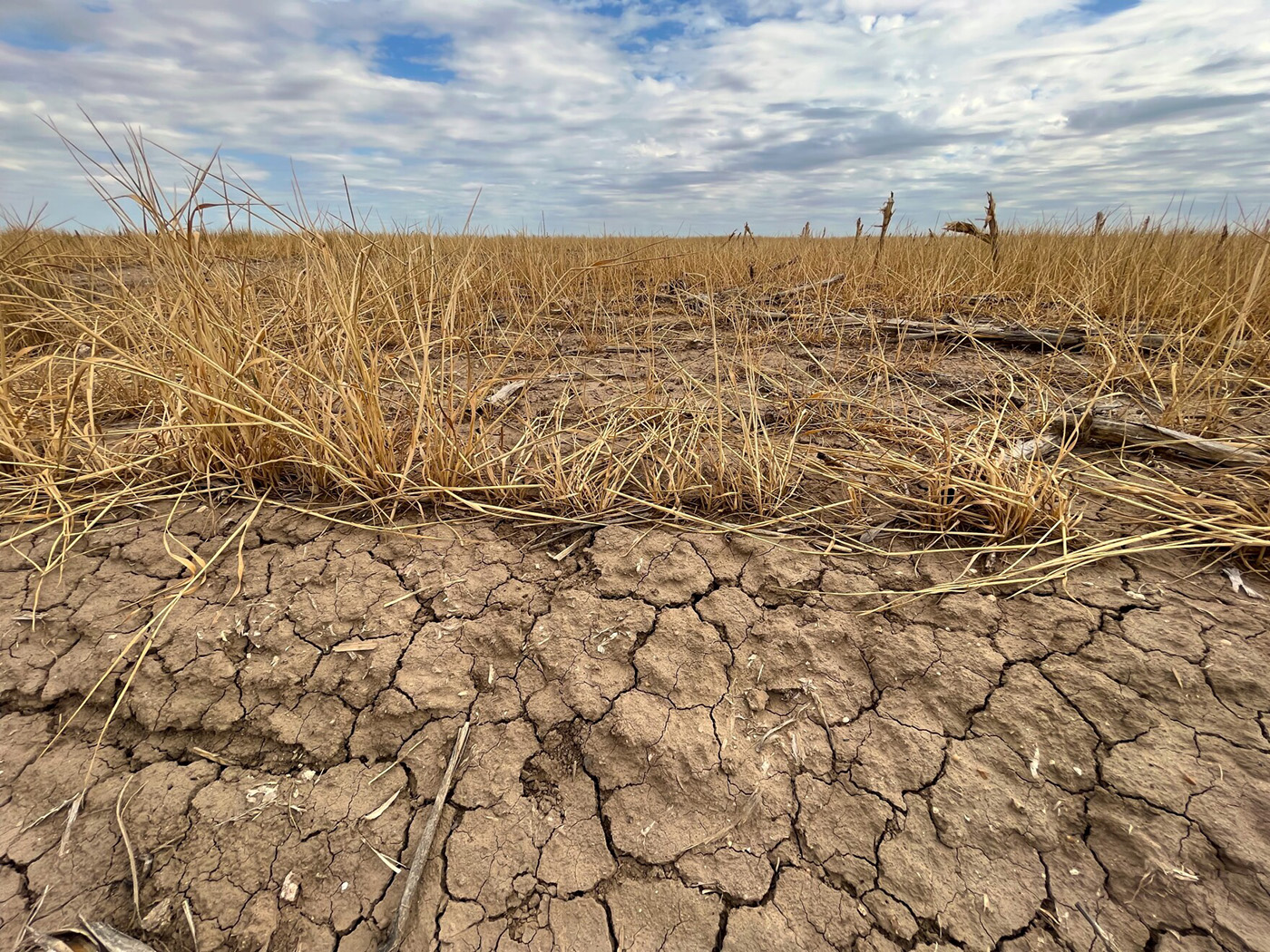
Wheat prices have bounced between $10 and $12 per bushel since setting an all-time record north of $13 in March. So it might stand to reason that farmers should be able to make up for poor harvests by selling the wheat they do have for more money.
But it’s not that simple.
The US Department of Agriculture estimates that wheat fields statewide will average roughly 39 bushels per acre this year, down sharply from 52 bushels per acre last year. But many farms in the western half of the state will produce far less than that.
USDA projections for Lane County say wheat farmers here will end up harvesting an average of 27 bushels per acre — less than half of what the county’s farmers averaged last year.
At $11 per bushel, each acre of that average Lane County farmer’s land would bring in just under $300 this season. In order to recoup the costs of doing business, Ehmke said farmers here need to gross closer to $325 per acre.
Ehmke considers himself fortunate. He expects his wheat to end up higher than that 27 bushel average, something he credits to the way he lets his land rest between plantings. But even with conservative land management strategies, his fields might still only produce half of what they did last year — all because of too much heat and not enough rain.
And he figures that at least half the wheat fields in western Kansas won’t produce enough for farmers to break even.
“They’re losing money,” Ehmke said, “even with the highest price of wheat that we’ve probably ever seen in the past 50 or 100 years.”
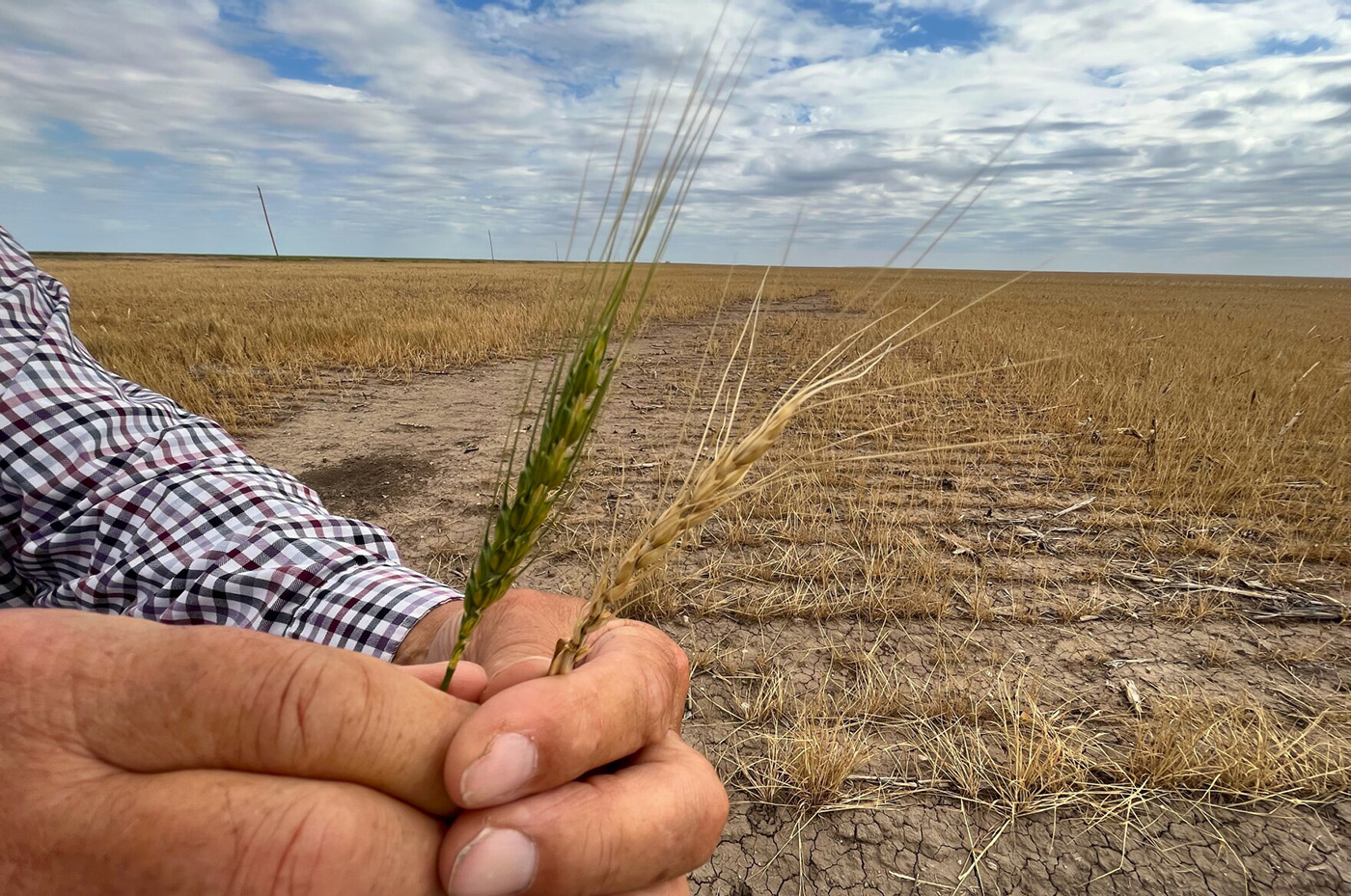
Part of the problem is an increase in costs. Farmers face higher expenses across the board this season, largely thanks to supply chain issues caused by the war in Ukraine and sanctions against Russia.
The price of diesel — the fuel required to run the tractors and trucks that keep farms going — reached an all-time high last month and remains more than $5.50 per gallon.
Nitrogen fertilizer prices also soared to record levels this spring, peaking above $1,500 per ton — more than twice what it cost one year ago.
“It’ll be a very difficult year,” Rejeana Gvillo with Farmers Business Network said. “Just because commodity prices are high, it does not mean that producers are better off.”
Gvillo, a senior commodity analyst with the national agricultural data and e-commerce platform, traveled across the state last month to survey crop conditions during the annual Kansas wheat tour.
She said the differences between wheat stands in eastern and central Kansas — areas that should still see a decent harvest this year — and western Kansas were stark.
“Shorter crop. Uglier fields,” Gvillo said. “As we drove west, it just got way worse.”
In past years’ wheat tours, Gvillo said she would wear a rain suit to walk into wheat fields because she would get soaked with dew. This year, she didn’t see any morning moisture on plants until the tour neared Wichita.
Many stands were in such bad shape that she could easily step between scrawny rows of wheat without touching the plants at all. In some of the hardest-hit areas, she found seeds lying in the dirt that never got the chance to sprout.
“It was so dry, the grass on the side of the road was dead,” Gvillo said. “And that’s weeds.”
Even some of the better-looking crops in western Kansas are so short — stunted by the heat and lack of moisture — that there’s concern about whether or not combines will be able to reach low enough to harvest them properly.
And with those high diesel costs, she said, it might not be financially feasible for some farmers to run a combine over their wheat — even if the crop could produce a few bushels per acre.
Kansas isn’t called the Wheat State for nothing. It produced nearly one quarter of all American wheat harvested last year.
But this year’s Kansas wheat crop has been through a lot of hardship since seeds went into the ground this past fall.
There was the Dec. 15 storm that battered the region with widespread wildfires, hurricane-force wind gusts and swirling clouds of dirt that zapped crops with static electricity and evoked images of the Dust Bowl.
Static electricity damage to wheat from dirt storm pic.twitter.com/cRmNpiGLd5
— Clay scott (@scottwestacre) December 16, 2021
This spring, extreme weather has continued to damage some wheat stands with hail, above-average winds and freezing temperatures.
Then there’s the months-long drought that continues to ring the region dry of what little moisture it has.
Every inch of western Kansas remains blanketed by some level of drought. Virtually all of southwest Kansas faces extreme or exceptional drought, the two most severe levels on the U.S. Drought Monitor’s scale. Some areas in the southwest corner of the state have been in extreme or exceptional drought since Christmas.
Even with some recent precipitation, much of western Kansas would still need an additional three to five inches of rain just to get back to its historical year-to-date average.
Most of the wheat stands in western Kansas are dryland, meaning they’re not irrigated. So growth depends on how much it happens to rain on that particular field.
But after months of wheat farmers hoping for rain, that window has closed.
“It’s basically too late for moisture to help,” Gvillo said. “In fact, water would probably hurt.”
That’s because rain would be more likely to increase the risk of disease or fungus than it would increase the yield at this late stage in the plant’s growth.
Marsha Boswell, vice president of communications with the Kansas Association of Wheat Growers, said the good news is that modern varieties of wheat seed have been bred to handle this dry climate.
“Wheat is one of the most drought-tolerant crops and one of the most resilient crops,” Boswell said. “But it does need just a little bit of help.”
The conditions this year have pushed those crops to the limit.
The US Department of Agriculture says 41% of Kansas wheat is in “very poor” or “poor” condition. That’s up from just 14% at this time last year.
The Wheat Quality Council estimates that more than one of every ten wheat fields in Kansas will be abandoned, meaning they didn’t grow enough crop to bother harvesting it. And that number is likely to creep up in the coming weeks.
“Abandonment is going to be a lot higher than an average year,” Boswell said. “There’s no way to harvest some of those acres where there’s just next to nothing left.”
Just finished up with our crop ins appraiser. Over half of our acres will not see a combine. Turns out CC wheat needs 10 lives with only 1” of precip pic.twitter.com/0eIIwe1jvC
— luke jaeger (@luke_jaeger) May 21, 2022
In other parts of the High Plains, the outlook is even more grim.
To the west in Colorado, projections say nearly one-third of wheat fields won’t produce enough to bother harvesting. In Texas, around three-quarters of the crop will likely be abandoned.
Daryl Strouts is president and CEO of the Kansas Wheat Alliance, which helps get new wheat varieties developed by Kansas State University out to farmers. If the state hadn’t already spent decades developing those drought-tolerant wheat breeds, he said, this year could have been much worse.
Kansas is still expected to harvest more than 250 million bushels of wheat this season. But that total will be down more than 100 million bushels from last year.
With record high wheat prices, that drop in production really adds up.
If you take those missing 100 million bushels and multiply them by the $11 per bushel that farmers could have potentially sold them for this year, it means the drought could cause the Kansas economy to miss out on more than one billion dollars.
“I’m always reminded of an old proverb,” Strouts said. “A farmer that has too much water has a lot of problems. A farmer that doesn’t have enough water has only one.”
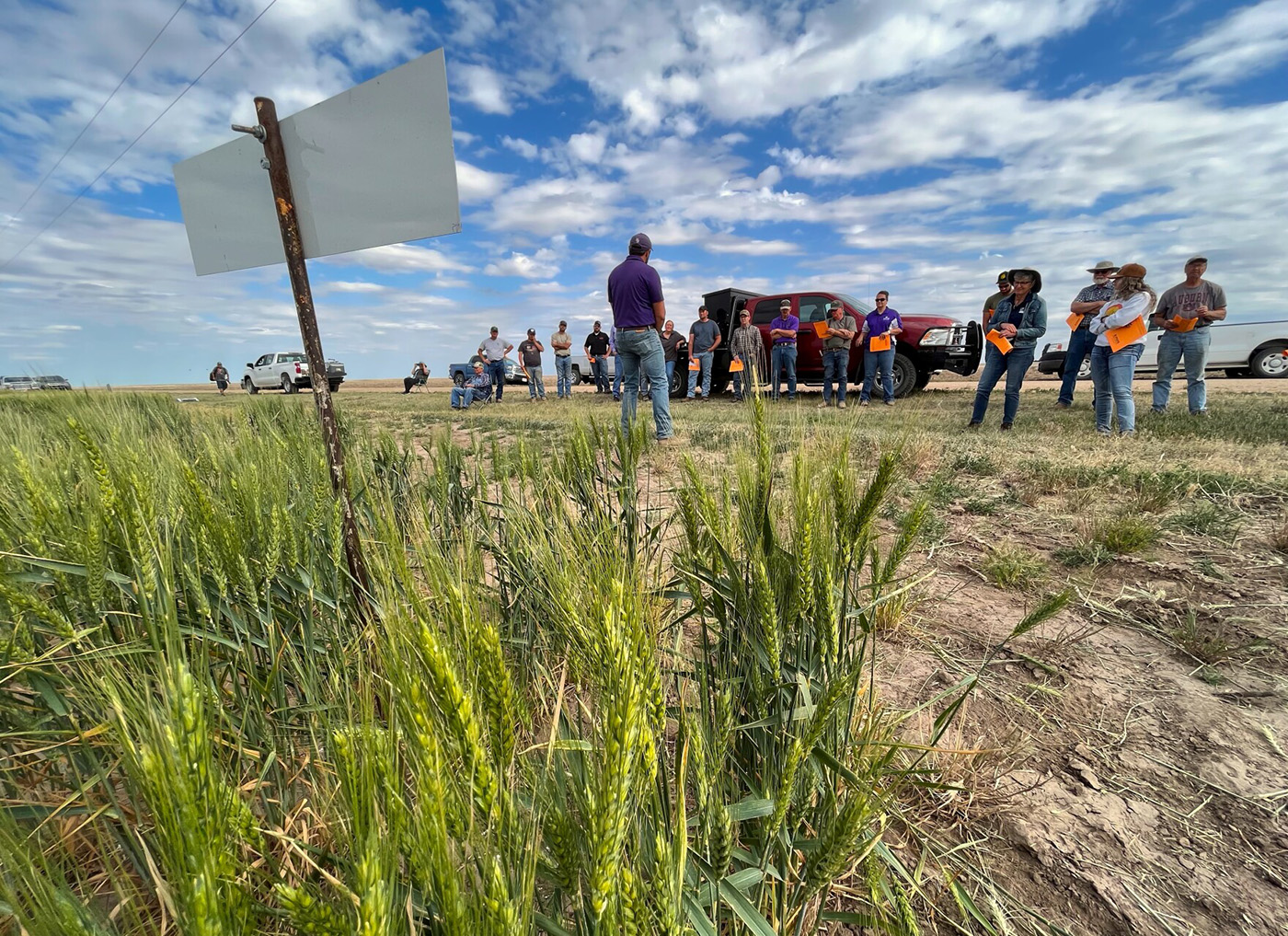
Now, global events have put even more pressure on Kansas wheat fields to produce food that millions of people around the world desperately need.
But even before this year’s drought, the total number of acres planted with wheat nationwide had been on a steady decline for decades as other crops like corn and soybeans became more profitable.
Two decades ago, the US produced one quarter of the world’s wheat exports. By last year, that number was down to just 13% as other countries took a larger share. Two of those counties were Russia and Ukraine, which have recently accounted for roughly one-third of the world’s wheat exports.
Now, Russia is blocking Ukraine from exporting some 20 million tons of wheat. And the war will likely prevent many Ukrainian farmers from harvesting or exporting this year’s crop.
Antonina Broyaka has seen how the Russian invasion has affected Ukraine’s communities and industries first-hand.
Until earlier this spring, she worked as dean of the agricultural economics department at the Vinnytsia National Agrarian University, just a few hours drive southwest of Kyiv. When Russia’s invasion began, she and her family fled to Kansas State University, where Broyaka studied nearly two decades ago.
She estimates that around 40% of Ukraine’s winter cropland has been lost because it’s become unsafe or is occupied by Russia.
Ukraine generally exports five to six million tons of grain per month. But most of that went out through Black Sea ports that are now blocked by Russia.
The country has still been able to export around one million tons of grain per month through rail and river transportation, Broyaka said, but that multimillion-ton deficit leaves a gaping void in the global food supply.
“Ukraine feeds around 400 million people in the world, so people will starve,” Broyaka said. “Some countries will need to replace that shortage.”
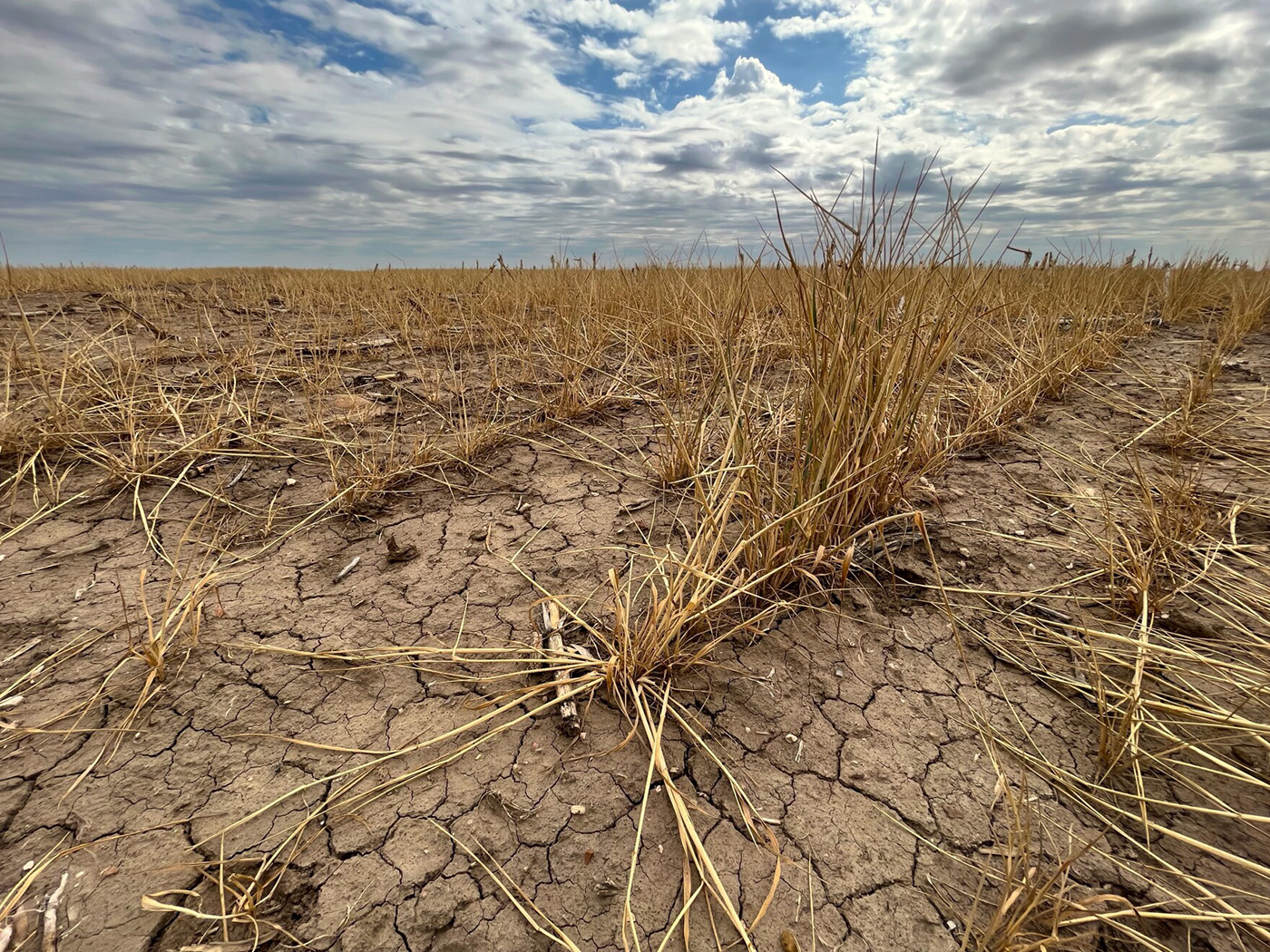
Another concern is Ukraine’s ability to store whatever grain its farmers are able to harvest this year.
Some of its large storage facilities have been destroyed by Russian bombings or left in occupied territory. Broyaka said many of the facilities that are accessible remain half-full with grain from the previous harvest that Ukraine hasn’t been able to export.
She’s also worried that Russia will continue to hold Ukraine’s wheat hostage in Black Sea ports as part of its political strategy. Russia could use that bargaining chip to blackmail nations that rely on Ukraine’s grain exports, pressuring them to support Russia’s military actions.
“That is a global problem,” Broyaka said, “and if the world will not help Ukraine to stop Russia, it will get worse.”
Recent reports warn that just 10 weeks’ worth of wheat remain in global stockpiles.
The U.S. exports more wheat than it imports, so the disruptions in Ukraine are unlikely to cause widespread food shortages here. But prices for wheat-based items like cereal and baked goods have already gone up.
For those living in countries that depend heavily on Ukrainian wheat, the consequences could be devastating. People in places like Egypt, Lebanon and Pakistan, for example, already face skyrocketing bread prices and shortages that put them at risk of going hungry.
On top of that, the world’s other leading wheat producers, India and China, have seen their crops damaged by blistering heat and overwhelming rains, respectively. Just last month, India sent wheat prices climbing yet again when officials stopped exporting the grain altogether because of worries about having enough for its domestic population.
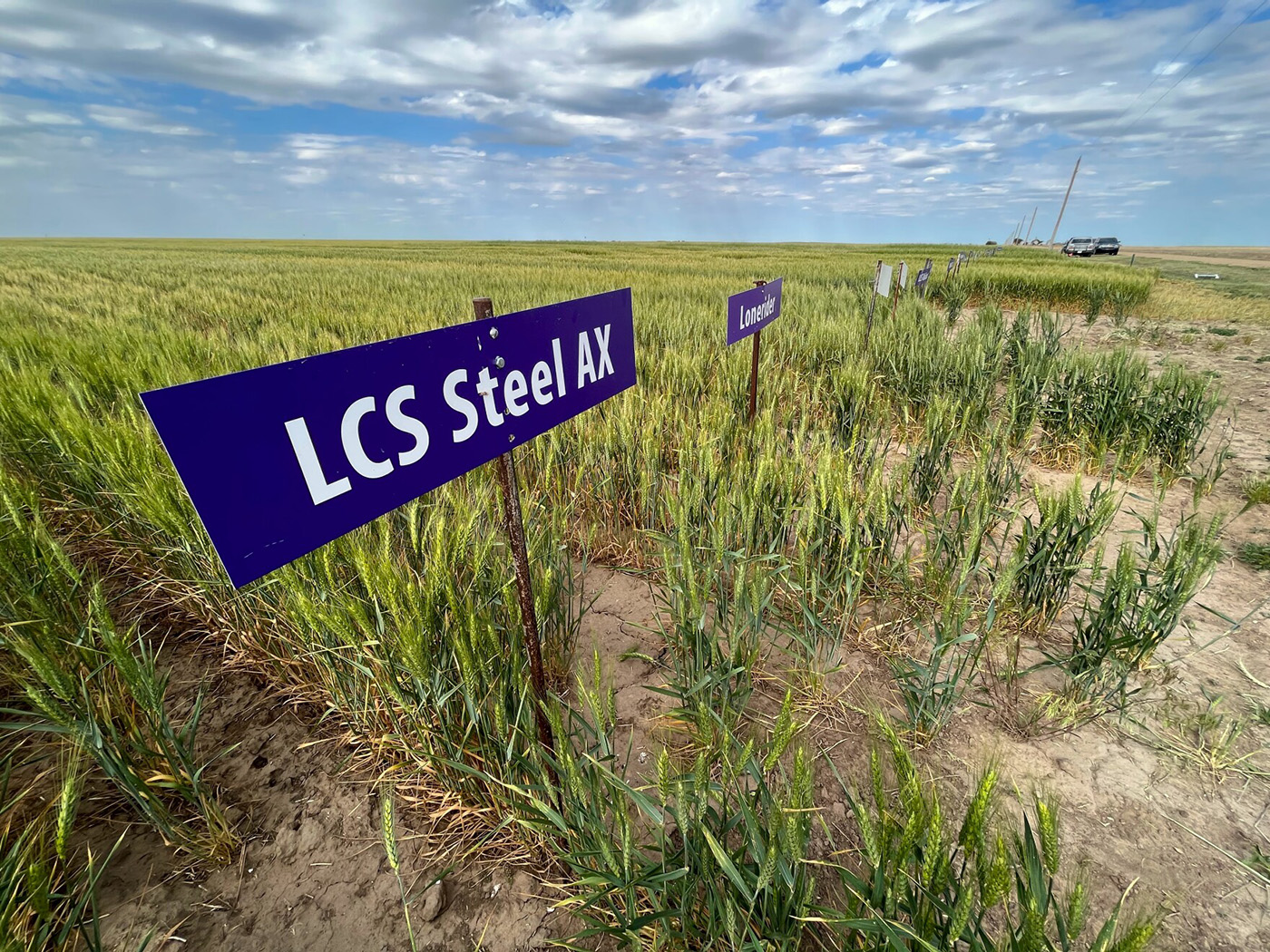
Ernie Minton, dean of Kansas State University’s College of Agriculture, said the places most likely to be hurt by this shock to the food system are ones where millions of people already live on the edge of malnutrition.
“That is the really disturbing part,” Minton said. “The countries and the individuals that are impacted most are the ones that are least capable of shouldering that kind of shock.”
So how could the international community help? Building new grain storage infrastructure in Ukraine, Broyaka said, or investing in temporary plastic storage options — like the grain bags that K-State has been evaluating in parts of Africa — to increase Ukraine’s capacity in the short term.
Farming regions like Kansas could also help by exporting more grain. Roughly half of the wheat harvested in Kansas in a given year gets exported abroad, Minton said.
But increasing wheat production isn’t something that can happen overnight.
Here in Kansas, farmers planted their winter wheat last fall, months before Russia invaded Ukraine. So by the time global markets began feeling strained from the war, there wasn’t anything Kansas farmers could do to try to grow more, even if the rains would have allowed.
But, Minton said, that’s why K-State’s long-term research into developing new wheat varieties that can withstand future Kansas droughts is so vital.
“These are times when we really need to be cognizant of how fragile this global food issue is,” Minton said. “We all have to get involved and look for solutions, and there may not be easy ones in the short run.”
Furthermore, wheat is far from the only crop for which the world depends on both Ukraine and Kansas.
Ukraine is also one of the world’s largest corn exporters, accounting for roughly 17% of global exports. As planting time arrives for that spring grain, questions remain about how much Ukrainian farmers will be able to produce and export this year.
“Will Ukrainian farmers have access to the seeds? The fertilizer inputs? The fuel they need to run their equipment?,” Minton said. “That’s certainly a real concern.”
If drought continues in western Kansas, it is likely to limit the state’s ability to export its own corn to help make up for that deficit.
And even though this winter wheat season isn’t over yet, there are already concerns about next year.
Gvillo, the commodity analyst, said it would take superb harvests from all of the world’s major wheat producers to stabilize global supplies, and it doesn’t look like that’s going to happen this year. That would ratchet up the pressure on the 2023 wheat crop before it’s even planted.
And as the Kansas drought and Ukraine war drag on into uncertain futures, she said, global grain markets are likely to remain strained for months or even years.
“We’re not out of it yet,” Gvillo said. “I think this time next year, we’ll be having the same conversation.”
David Condos covers western Kansas for High Plains Public Radio and the Kansas News Service. You can follow him on Twitter @davidcondos.
The Kansas News Service is a collaboration of High Plains Public Radio, Kansas Public Radio, KCUR and KMUW focused on health, the social determinants of health and their connection to public policy.
Invest in quality science journalism by making a donation to Science Friday.
David Condos is Southern Utah Reporter for KUER. He’s based in St. George, Utah.
IRA FLATOW: This is Science Friday. I’m Ira Flatow. And now it’s time to check in on the state of science.
SPEAKER 1: This is K–
SPEAKER 2: For WWNO–
SPEAKER 3: St Louis Public Radio–
SPEAKER 4: Iowa Public Radio news.
IRA FLATOW: Local stories of national significance. As Russia’s war on Ukraine continues, food shortages are cropping up for countries that rely on Ukraine’s normally abundant wheat harvest– Bangladesh, Egypt, Pakistan, and others. Shortages are driving up the prices for wheat to near record highs. And in the US, normally abundant wheat crops from Kansas could potentially have help.
The wheat state produced nearly a quarter of US wheat last year, but this year’s wheat crop, planted last fall, may not help as much as hoped because after months of drought, the Kansas wheat harvest is looking frustratingly small. High Plains Public Radio reporter David Condos is here with the story of the state of the wheat in Kansas. Welcome to Science Friday, David.
DAVID CONDOS: Yeah. Thank you for having me, Ira.
IRA FLATOW: Nice to have you. OK, how exactly is this year’s wheat crop looking compared to last year?
DAVID CONDOS: Yeah, it’s not great, unfortunately, especially for some of the farmers out in Western Kansas. Looking statewide, the US Department of Agriculture says about 40% of Kansas wheat is in poor or very poor condition. And that’s up from just 13% at this time last year. And as you mentioned, Kansas produces a ton of wheat, but there’s expected to be a steep drop from last year. And when all is said and done, the state’s total harvest is expected to be close to 100 million bushels smaller than last year.
So that’s a big drop. What does that look like? When you think of a wheat field, you might picture in your mind this stock image of a beautiful field full of this tall wheat swaying in the breeze. A lot of fields look very different from that this year. I talked with some people who cross the state surveying crop conditions, and they said it’s common for wheat to look scrawny and brown.
In some places, you can see these deep cracks in the hardened dirt between the rows from being baked in the sun. Even among decent-looking wheat, the plants may be so short, so stunted by this drought, that there’s been real concern about whether or not combines will be able to reach low enough to harvest them properly. And so I rode along with Western Kansas wheat farmer Vance Ehmke, and he gave me a tour of some of these hard hit fields near his property, and here’s how he described the scene.
VANCE EHMKE: There’s nothing out there. It’s just ankle high straw. The yield on that is zero.
IRA FLATOW: Yeah. These are not amber waves of grain, are they?
DAVID CONDOS: No. No. Yeah, it’s so bad that projections estimate that maybe 1 of every 10 fields planted with wheat in Kansas will end up being abandoned because there just isn’t enough of the crop to bother harvesting.
IRA FLATOW: Yeah, and of course, this shortage is all because of the drought. How bad has the drought been?
DAVID CONDOS: It’s been bad. Maybe the worst drought here in a decade. Modern wheat seeds have been bred to be more drought-resistant, but the conditions this year have just pushed them to the limit. And so the entire western half of the state of Kansas is in some level of drought and has been for months. Some parts of Southwest Kansas have been experiencing extreme or exceptional drought, the two highest levels on the US Drought Monitor scale since Christmas.
And so while we have gotten some rains recently, it’s too late in the growing cycle for this wheat crop for that rain to even help it. Basically, too little, too late, at least for this year. And when you think about how important that is for the wheat in this area, a lot of it is dry land, meaning it’s not irrigated and depends entirely on rainfall for all of its water. And some of these places are so deep in drought that even after some recent rains, it would still take an additional three, four, five inches of rain just to get back to their year-to-date average.
IRA FLATOW: No kidding.
DAVID CONDOS: And I talked with Daryl Strouts, who heads up the Kansas Wheat Alliance, and here’s how he put it.
DARYL STROUTS: I’m always reminded of an old proverb that says that a farmer that has too much water has a lot of problems. A farmer that doesn’t have enough water has only one. And I think that’s kind of where we are.
DAVID CONDOS: Just to put that in perspective, the definition of a desert is a place that gets 10 inches of precipitation or less than a year. And we’re about halfway through the year, and lots of Western Kansas hasn’t gotten even 5 inches of precipitation yet. So it’s essentially desert conditions for a lot of these farmers.
IRA FLATOW: And of course there’s a wheat crop that’s supposed to go into the ground in the fall. So it’s too late to plant more wheat until next year, right?
DAVID CONDOS: Right. Yeah. And that’s something, like you mentioned, Ukraine, that the wheat crop that they’re harvesting now, that was planted months before the invasion of Ukraine. And so it’s not something where you can just create more wheat. The next wheat crop will be coming up– be planted this fall. And so who knows how the drought might impact that as well.
IRA FLATOW: Yeah. What about states, other states that produce a lot of wheat? Have they been having the same drought issues?
DAVID CONDOS: Yeah, a lot of them have. And while Kansas is the top state for this winter wheat, there’s plenty grown in other neighboring states across the Great Plains. And the drought definitely hasn’t stopped at our state line.
If anything, it has been worse in some of these other states. And like I mentioned earlier, it’s estimated that at least 10% of the wheat fields here in Kansas won’t produce enough wheat to bother harvesting. Estimates say that might be more. Maybe even a third of wheat fields could be abandoned in Colorado or even up to 3/4 of fields in Texas.
IRA FLATOW: I talked about this global food shortage. Are other countries that are wheat producers around the world having their own weather issues this year?
DAVID CONDOS: Yeah, and it’s been a global problem. And I think it really highlights the fragility of the global food system because the world desperately needs this wheat right now. But like you mentioned, it’s not just Kansas that’s having trouble meeting that need. Other big wheat producers, like India and China, have also seen weather damage their crop from either too much heat or even too much rain. It can also damage the crop and has done that.
IRA FLATOW: And of course, when you talk about wheat and production and farmers, you’re talking about money. Wheat prices are really high. They’re not getting that money if they can’t harvest the wheat.
DAVID CONDOS: Right. And that’s obviously the frustrating thing for farmers in this area is that wheat demand is up, and prices have been near record levels. But even the crops that are above average this year, they’re going to harvest significantly less than they did last year.
And for a lot of farmers in Western Kansas, their harvests might not even be enough to cover their costs because remember, the price of other things that farmers need, like diesel fuel and fertilizer, have also gone up this year. And so that Western Kansas farmer that I talked with, Vance Ehmke, figures that at least half of the wheat fields in his region, you won’t harvest enough for those farmers to break even.
VANCE EHMKE: They’re losing money, even with the highest price of wheat that we’ve probably ever seen in the past 50 or 100 years.
IRA FLATOW: Wow. That’s sad to hear. What about long-term predictions for the climate in Western Kansas? Does that suggest that we’re in for a long period of drought?
DAVID CONDOS: Yeah. And I mean, the scary thing is just looking at short term, this current drought is still going on. It’s been going on for months, and it’s still here, and no one knows when it might end. Projections say it could stick around for months through the summer. But Kansas historically is no stranger to droughts that can last much longer than that, if you think of the Dust Bowl.
So this drought could last even into next year. But longer term, I think it does highlight the challenges that farmers face in a dry area like this, where there’s a delicate balance that climate change could upset because if parts of Western Kansas are already so dry that growing wheat is a bit of a challenge, any further incremental changes in how hot or how dry this region becomes will make farming that much harder.
And so if you think of Western Kansas as this borderline region or this canary in a coal mine for looking at how drought and farming and climate change are interacting, we could see significant impacts from that here in coming years, maybe even before some of those changes start impacting other places east of here.
IRA FLATOW: Considering how frustrating it sounds that farmers are and how little money they’re making on this wheat, are they talking about either possibly planting less wheat next year or switching to possibly less water-intensive crops?
DAVID CONDOS: Yeah, like you mentioned, there are other crops that might need even less water. Like, cotton, for example, is one crop that’s starting to be grown in Southwest Kansas. The other thing, like I mentioned, is these new varieties of drought-resistant wheat seeds that researchers have been breeding for the past few decades and have helped this year from becoming much worse than it might have otherwise been.
And the last thing is when you’re thinking about water conservation and soil conservation and soil health, that farmer I talked with, Vance Ehmke, he gave me the example, when he was driving me around, that he was looking at his fields and some neighboring fields that were doing worse. And he expects his crop to be a little above average this year, and he credits that to caring for his soil and letting the ground rest.
And when he drove me around and pointed out some of those fields that look worse, you could still see some of those corn stalks among the shriveled wheat from the corn harvest that came right before they planted the wheat. And that means that soil didn’t get to rest and recover in between those plantings. And so there are some conservation practices like that that at least in the mind of some farmers would really help as well.
IRA FLATOW: So we’re keeping our fingers crossed for you. Thank you for taking time to be with us today, David.
DAVID CONDOS: Thank you again for having me on.
IRA FLATOW: David Condos, reporter for High Plains Public Radio and the Kansas News Service. David is based in the town of Hays, Kansas.
Copyright © 2022 Science Friday Initiative. All rights reserved. Science Friday transcripts are produced on a tight deadline by 3Play Media. Fidelity to the original aired/published audio or video file might vary, and text might be updated or amended in the future. For the authoritative record of Science Friday’s programming, please visit the original aired/published recording. For terms of use and more information, visit our policies pages at http://www.sciencefriday.com/about/policies/.
Christie Taylor was a producer for Science Friday. Her days involved diligent research, too many phone calls for an introvert, and asking scientists if they have any audio of that narwhal heartbeat.
Ira Flatow is the founder and host of Science Friday. His green thumb has revived many an office plant at death’s door.